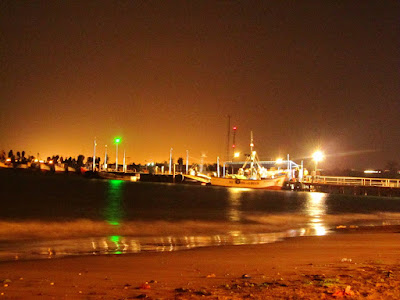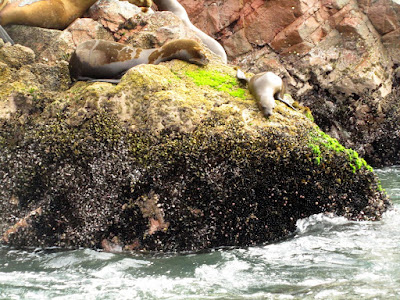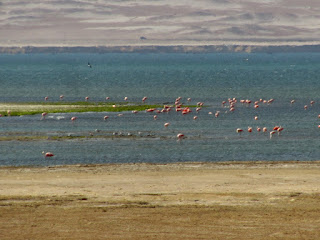Paracas, where the hot desert meets the cold seas
On our way down south from Lima we decided to make a stop in Paracas, a little town in the middle of the endless Peruvian desert driven by fishing, tourist attractions, and bird poop.
Since we missed our trip to the Galapagos islands because of the end-of-year tourist rush which made the flight prices hit record prices and after that everything got fully booked, we decided that the stop in Paracas was mandatory.
The Ballestas islands (about 1 hour offshore in a speed boat) are in fact known as the 'Galapagos of the poor'. It doesn't have the same amount of weird animals as the famous Galapagos and you don't get as close and personal to them as you cannot go ashore, but the cheaper prices makes it easily reachable for different sizes of wallets.
Since it is in its essence a fisherman village we found it safe to have a tasty cheviche, a traditional dish of most latin american countries facing the Pacific Ocean, where mostly raw fish or seafood is marinated in lemon juice for about an hour (or less, depending on the fish) and is later served with onions and spices. It's very simple and it can be really tasty and a very refreshing meal.
Next morning, we left the port of Paracas on a speed boat with a bunch of other tourists in life jackets and with cameras ready to shoot.
The view of the islands is unique. Thousands and thousands of birds cover most of the islands surfaces and bellow the beaches, laying under huge arches (ballestas), are inhabited by sea lions and penguins.
Some of the beaches are maternities, where the baby sea lions are born and later encouraged by their moms to make their first 'steps' into the cold water.
The reason why the water is so cold and there is such an important marine bio diversity here is because of the Humboldt current, which hits the american continent directly in this region, and brings cold water directly from the Antarctic Ocean upwards towards the Ecuador.
The time around the islands passed a lot faster than we wanted and soon it was time to go back to land. On the way back we saw some drawings similar to those in Nazca and with the same mysticism, nobody knows who did it and the reason for it. The drawing is huge (about 150 meter long) and is called 'candelabro', nevertheless it is difficult to access and has been standing there protected by the dunes for at least 3 centuries. Impressive.
After this tour we wanted to see more, and entered a mini van in direction to the Reserva Nacional de Paracas. Here we saw deserts covered with fossilized seashells, reminding us that we might soon go underwater again.
Endless deserted landscapes only crossed by the Pan-american road and the odd, lonely car.
Beautiful cliffs and beaches where the desert meets the cold antarctic currents.
Desert, more desert, colors and tonalities.
Beaches with red sand
Other places where for sure humans should find a different type of transportation.
Blue skies
and our first glance of flamingos.
So after all, the Galapagos of the poor, is a very very rich place full of different things to see and with such a dimension that it's difficult to contain a big..WoW.
Since we missed our trip to the Galapagos islands because of the end-of-year tourist rush which made the flight prices hit record prices and after that everything got fully booked, we decided that the stop in Paracas was mandatory.
The Ballestas islands (about 1 hour offshore in a speed boat) are in fact known as the 'Galapagos of the poor'. It doesn't have the same amount of weird animals as the famous Galapagos and you don't get as close and personal to them as you cannot go ashore, but the cheaper prices makes it easily reachable for different sizes of wallets.
Since it is in its essence a fisherman village we found it safe to have a tasty cheviche, a traditional dish of most latin american countries facing the Pacific Ocean, where mostly raw fish or seafood is marinated in lemon juice for about an hour (or less, depending on the fish) and is later served with onions and spices. It's very simple and it can be really tasty and a very refreshing meal.
Next morning, we left the port of Paracas on a speed boat with a bunch of other tourists in life jackets and with cameras ready to shoot.
The view of the islands is unique. Thousands and thousands of birds cover most of the islands surfaces and bellow the beaches, laying under huge arches (ballestas), are inhabited by sea lions and penguins.
Some of the beaches are maternities, where the baby sea lions are born and later encouraged by their moms to make their first 'steps' into the cold water.
The reason why the water is so cold and there is such an important marine bio diversity here is because of the Humboldt current, which hits the american continent directly in this region, and brings cold water directly from the Antarctic Ocean upwards towards the Ecuador.
The Humboldt current is the most productive marine Ecosystem in the WorldThere are so many birds in these islands that the surface is actually covered in poop, or guano as they prefer to call it over there. This guano has a great value as a very effective fertilizer, and has been produced, collected, transported and sold over many years, actually all the way back to the Inkas. In fact there are only a few people living in the islands and those are guards to make sure of no guano piracy.
The time around the islands passed a lot faster than we wanted and soon it was time to go back to land. On the way back we saw some drawings similar to those in Nazca and with the same mysticism, nobody knows who did it and the reason for it. The drawing is huge (about 150 meter long) and is called 'candelabro', nevertheless it is difficult to access and has been standing there protected by the dunes for at least 3 centuries. Impressive.
After this tour we wanted to see more, and entered a mini van in direction to the Reserva Nacional de Paracas. Here we saw deserts covered with fossilized seashells, reminding us that we might soon go underwater again.
Endless deserted landscapes only crossed by the Pan-american road and the odd, lonely car.
Beautiful cliffs and beaches where the desert meets the cold antarctic currents.
Desert, more desert, colors and tonalities.
Beaches with red sand
Other places where for sure humans should find a different type of transportation.
Blue skies
and our first glance of flamingos.
So after all, the Galapagos of the poor, is a very very rich place full of different things to see and with such a dimension that it's difficult to contain a big..WoW.



























Comments